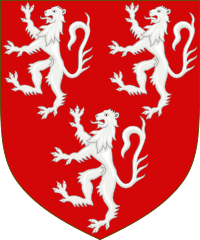William II, Earl of Ross
William II, Earl of Ross (Gaelic: Uilleam; died c. 1323) was ruler of the province of Ross in northern Scotland, and a prominent figure in the Wars of Scottish Independence.
William | |
|---|---|
A bust of William, made for display in the Tain Museum | |
| Mormaerdom | Ross |
| Successor | Hugh, Earl of Ross |
| Born | bef. 1274 |
| Died | c. 1323 Delny, Ross-shire, Scotland |
| Family | Ross |
| Wife | Euphemia |
| Father | William I, Earl of Ross |
William was the only child of William I, Earl of Ross and his wife Jean Comyn, daughter of William, Earl of Buchan. He succeeded to the earldom on the death of his father in 1274. In 1284 he joined with other Scottish noblemen who acknowledged Margaret, Maid of Norway as the heir to the unfortunate Alexander III.[1] Following Margaret's death, he sided alternately with the Scottish and English interests. In 1291 he paid homage to Edward I of England at Berwick recognising him as overlord of Scotland.[2] He was chosen as an auditor at the trial between John Balliol and Robert Bruce, when they competed before Edward to decide who would take the throne of Scotland.
William was one of the leaders of the Scottish army at the Battle of Dunbar in 1296, when Edward invaded Scotland to punish John Balliol for refusing to support the English invasion of France. After the Scottish defeat, he was captured by the English and sent to the Tower of London, where he remained until September 1303, when an order was issued for his escort to Scotland. He reached Perth in December, and stayed there with Edward, Prince of Wales until he was sent home in February. Later in 1304 he was with King Edward at Dunfermline, who bestowed upon him a horse, armour, and other presents, as well as appointing him Warden beyond the Spey.[2]
In 1306, Robert's wife Elizabeth, his daughter Marjorie, and other Bruce supporters took refuge from the advancing English army in the chapel of St Duthac at Tain in Ross, while on their way to the safety of Orkney.[3] However, William violated the sanctuary, took them prisoner, and handed them over to the English. They were sent as prisoners to England where two of the women were caged outdoors for four years, and the women were not liberated until 1314.[2][4][5]
.png)

This put William in a dangerous position when the Bruce revival began in the same year, 1306. He found himself being attacked by King Robert in the south, and by Lachlann Mac Ruaidhrí in the west. In 1308, Edward II wrote to him thanking him for his services and requesting further aid, but when Bruce came north, William submitted to him. William later wrote to Edward apologising for the submission to King Robert, and requesting help to repel his invasion of Ross.[2]
Nevertheless, William is one of the eight earls whose name appears on the Declaration of Arbroath of 1320, which was sent to the Pope requesting he recognise Scotland's independence, which he did. William died three years later, at Delny in Ross. He had married a lady named Euphemia, who was likely the daughter of Sir Hugh de Berkeley, Justiciar of Lothian.[6] They had three sons and two daughters:[2]
- Hugh, Earl of Ross
- Sir John Ross, married Margaret Comyn, daughter of John, Earl of Buchan
- Sir Walter Ross, killed at Bannockburn
- Isabella Ross, married Edward Bruce, Earl of Carrick
- Dorothea Ross, married Torquil MacLeod of Lewis
References
Notes
- Foedera, p228
- Paul, Sir James (1909). The Scots Peerage. Edinburgh: David Douglas. Retrieved 2015. Check date values in:
|accessdate=(help) - Munro, R.; Munro, Jean (2005). Tain Through the Centuries. Edinburgh: Birlinn Limited. Retrieved 2015. Check date values in:
|accessdate=(help) - Education Scotland, "Elizabeth de Burgh and Marjorie Bruce" Archived 2015-07-11 at the Wayback Machine, Education Scotland (a Scottish government agency, "the national body in Scotland for supporting quality and improvement in learning and teaching"). Retrieved July 11, 2015.
- David Cornell, "Bannockburn: The Triumph of Robert the Bruce", Yale University Press,, 2009. Retrieved July 11, 2015.
- John P. Ravilious, The Ancestry of Euphemia, Countess of Ross: Heraldry as Genealogical Evidence, The Scottish Genealogist, Vol. LV, No. 1 (March 2008), pp. 33–38
Bibliography
- Barrow, G.W.S., Robert Bruce and the Community of the Realm of Scotland, (Edinburgh, 1988)
- John P. Ravilious, The Ancestry of Euphemia, Countess of Ross: Heraldry as Genealogical Evidence, The Scottish Genealogist, Vol. LV, No. 1 (March 2008), pp. 33–38
- Rymer, Thomas,Foedera Conventiones, Literae et cuiuscunque generis Acta Publica inter Reges Angliae. London. 1745. (Latin)